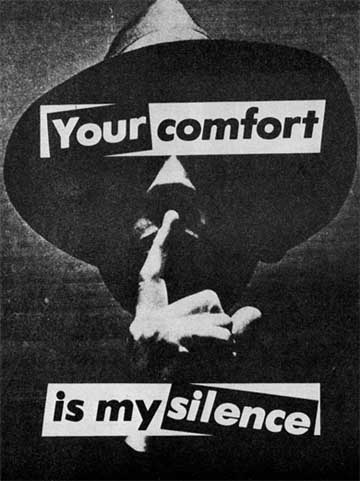
Barbara Kruger, 1981, photo montage.
Welcome back to BOMB in the Building, where each week we’re featuring a vintage BOMB interview relating to a Season 5 artist. This week, we stepped back into our archive looking for a piece by John Baldessari only to find this portfolio of his work from 1986. But since we promised you an interview, we stepped back further in time to find this conversation that correlated to Baldessari’s work instead. In this interview from BOMB Issue 3, Summer 1983 (26 years ago!), Richard Prince and Art21 artist Barbara Kruger ask each other the same question that result with some varied responses. Read the full interview here.
Richard Prince: What about all these recorded conversations we hear about these days?
Barbara Kruger: Presidents, interview, things like that?
RP: Yes.
BK: Well, in most cases recording seems to offer both the curiosity of replication and the resoluteness of evidence.
RP: Does this have anything to do with the pictures we’re looking at?
BK: Yes. I think in some ways their definitions are interchangeable.
RP: Fiction feels good and recanting causes stress. Like lying, in the physiological sense, the telling of a true story is an unnatural act. Do you think fiction has anything to do with replication?
BK: Pictures and words seem to become the rallying points for certain assumptions. There are assumptions of truth and falsity and I guess the narratives of falsity are called fictions. I replicate certain words and watch them stray from or coincide with the notions of fact and fiction.
RP: Some people think that things that sell the most are the best. How do you feel about being seduced by popular culture? Or are you?
BK: Being socialized within similar constructs of myth and desire, it is not surprising that most people are comforted by popular depictions. Sometimes these images emerge as “semblances of beauty;” as confluences of desirous points. They seem to locate themselves in a kind of free zone, offering dispensations from the mundane particularities of everyday life; tickets to a sort of unrelenting terrain of gorgeousness and glamour expenditure. It you and I think that we are not susceptible to these images and stereotypes than we are sadly deluded. But to have some understanding of the machinations of power in culture and to still joyously entertain these emblems as kitschy divinities is even more ridiculous. And for women it’s an extreme form of masochism.
RP: The fact that we use things that have possibly been observed or unconsciously collected by people other than ourselves…things that have previously been available to anyone who cared to use them—that kind of thing, given these conditions, do you think your work is produced or reproduced?
BK: Well, given your criteria it would seem that all work can be called reproductions to some degree since it incorporates certain styles or codes which preceded it. I think the difference lies in the acknowledgment of previous production within the work. This acknowledgment can function as a device which removes the “original” image from naturalness, perhaps suggesting either an implicit or explicit commentary. In my work I am interested in an alternation between implicit and explicit, between ingratiation and criticality. I also think about assumption, disbelief and authority, but there are no “correct” readings. Only reproductions and possibilities.
RP: A while ago we talked about “cool”. I remember saying something to the effect that “cool” was a prehistoric style. A little like being a dinosaur.
BK: If you think about words like primary and secondary, you could say that cool is mired in the secondary address. It is self-conscious without the presence of cameras and tape recorders. It has internalized their promises and threats. It is totally subsumed by style. Often, its repertoire is composed of gesture. It is celibate, but in an emergency it can fake pleasure pretty well. Its language is not of words but a kind of physical short handing; a verbal withholding. It wants you to think it’s detached. Do you think a lot about style?
RP: I’m misinformed about style. I always thought it had to do with being able to wear the same kind of a jacket for ten years. I don’t know. What I wonder is…is it possible to have style and be unreasonable at the same time?
BK: I think unreasonableness can mean any number of possible locations nearer or further away from the idea of reason. Because many of these positions are already coded, their shock value is tempered by style. A lot of times the idea of transgression really turns on a romantic conception of otherness; of a rebellion already tolerated. You know, the charming rogue, the picaresque cuteness of the bull in the china shop and in the art world, badness invades the atelier. Driving limos through heavy neighborhoods to look at the graffiti. Unstylish unreasonableness may be limited to the categories of the insane and the unpleasant (the poor, the unbeautiful, the unempowered). The non-romanticism of these kinds of otherness makes them unsightly and “vulgar” considerations for the polite company of international bohemia.
Read the full interview in BOMB Magazine here.